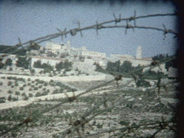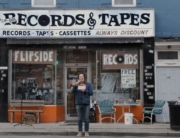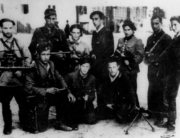Like diaries and letters in the old days, home movies are more and more being mined for their historical and sociological significance. The amateur footage edited together in Israel: A Home Movie, year by year from the 1930s through the 1970s, adds new perspectives for an international audience. It counters myths and official views, and recognizes what has changed over time.
Producer Arik Bernstein spent almost a decade soliciting and preserving 16mm, 8mm, and Super 8mm footage from people’s storage bins all over the country, collecting more than 600 hours of film. For almost a year, director Eliav Lilti sifted through to cull individual scenes that would resonate beyond the photographers and their families. The opening 1930’s scenes are already familiar from other documentaries—European refugees on boats exuberantly landing in Palestine and young pioneers turning the desert into farms. But what adds immeasurably to the visuals is the commentary by the families watching scenes they haven’t seen in decades, and kibitzing on people long gone or their long ago youth. A woman, who was one of those Romanian refugees, is still bitter about getting “the cold shoulder” from the Jews already living there, and images that look like carefree occasions are brought up short by the guilty admission of not knowing what parents and relatives were suffering in Europe at that same time.
War and violence are repeated experiences. A smiling youth is repeatedly shown as the last image a family had of this proud pilot before he flew off to his death in the country’s first war. One little child is sadly remembered as having died in a shelling (just as what happened in my brother-in-law’s family), and another relative is pointed out as having been “killed in a terrorist attack at about age 30.” Informal glimpses of generals, including Ariel Sharon and Moshe Dayan, adds to the jibing cynicism of the frontline soldier, even from Dayan’s sons, including actor/director Assi Dayan. There are many scenes of frolicking with friends on the beach. One has the sunken hulk of the guns and ammunition-laded ship the Altalena in the background, while later, color footage captures enemy airplanes buzzing overhead during the surprise start of the 1973 Yom Kippur War.
A primary reason to see this compilation is the unusually frank look at the changing perceptions of the indigenous Palestinian population, before and after independence in 1948 and after the Six Day War expanded the country’s boundaries. Before Israel’s statehood, the local Arabs are filmed as exotic fauna, driving camels through neighborhoods that were half-Arab and half-Jewish. Footage of Arab and Jewish friends playing together brings back fond memories of Arab housekeepers and market vendors. But the Palestinian families packing up wagons with all their belongings under the watchful eye of armed Israeli soldiers ruefully now look to the commentators like refugees, even as many repeat the government’s line that they fled their homes due to the panic stirred up by outside Arab propaganda. While the voices mention that Israelis still live in houses the Arabs left behind, the documentation of the demolition of a minaret leads to a heated discussion on whether it was a holy site and about its adjacent mosque’s conversion into a synagogue.
The first view of what became known as the Occupied Territories is the surreptitious filming of a divided Jerusalem through Jordanian barbed wire a week before the Israeli takeover in 1967 (see photo above). It looks like the whole country is celebrating when long lines of hikers joyously parade around the whole “liberated” city. The locals look on with mixed reactions that become grimmer as enthusiastic settlers move in first temporary, then permanently.
There are situations, names, and dates more of note for Israelis than American audiences, including informal clips of noted celebrities, such as the broadcaster who covered the 1972 Munich Olympics. David Ben-Gurion’s 1956 visit to the miserable transit camps for Jews who were suddenly expelled from Arab countries provides an ironic window on children’s experiences. One Moroccan chuckles that he has learned more about the Holocaust than the Israeli children of survivors. He had to explain to them that the common phrase about neighbors’ “dying of Buchenwald” didn’t refer to a disease.
Other documentaries have better used home movies and informal photographs to more insightfully explore specific slices of Israeli history–Ran Tal’s history of kibbutzim in Children of the Sun (2007), David Benchetrit’s Kaddim Wind: Moroccan Chronicles (2003) about Mizrahi immigrants, and the passage of Tel Aviv from Palestinian to Israeli in Tamar Tal’s Life in Stills (2011)–but the breadth of the everyman perspective makes this a worthwhile time travel.







When is the movie playing in Los Angeles ?
Thank you.
For those looking for the film in Los Angeles, the distributor let me know: “At the moment we’re looking for more art houses in the area of Los Angeles to screen the film.”